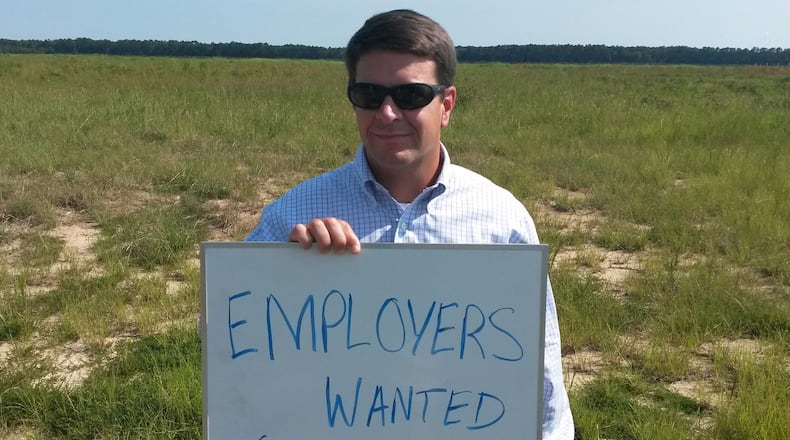Kempner’s Unofficial Business
I’ve been a reporter or editor since gas was about a dollar a gallon and “Hands Across America” was a thing. I’ve spent lots of time covering government, the environment and, for most of my career, business. But I don’t daydream about fiscal policy and corporate earnings. What I love about business is the strategy and the people and the journeys that those people take. I like irony and surprise and nuance. I’ve interviewed soldiers, oystermen, football stars, chicken plant workers, Fortune 500 CEOs, suburban activists and entrepreneurs dreaming big dreams. How cool is that? I’ve teared up in interviews, laughed inappropriately, been yelled at and snookered. I do like an adventure. Let’s see where this one goes.
I have to admit: The mega site that Georgia bought to attract a bevy of well-paying jobs is a beautiful thing to behold.
You have two Interstates (I-95 and I-16) right beside two interchanges. You’ve got Georgia’s rocking and rolling container port at Garden City maybe five miles away, and the Savannah airport whispering in your ear. And the site is maybe 12 minutes from Savannah’s scenic historic district and nightlife and pool of workers.
As if that wasn’t enough, we Georgia taxpayers shelled out tens of millions of dollars for a little nipping and tucking to make the 1,560-acre property in Pooler even more appealing. We added a miles-long, four-lane access road, a long stretch of railroad tracks and water and sewer lines (it turns out, plumbing is sexy). We even graded hundreds of wooded acres flat for a building site, just to be extra inviting.
So why is Georgia’s only bought-and-paid-for mega site so lonely?
There’s some truth to the cliché: Beauty is in the eye of the beholder.
Thirteen years after we started down this $60 million path (I repeat: $60 million), the mega site is without a mega employer.
The last big automaker to look at Georgia wasn’t interested. Too small, Volvo said. It wanted far more land for the 4,000 employees it has in mind. So instead, Volvo took a serious look at land maybe 20 miles away that hadn’t been prettied up, before recently settling on a site in South Carolina.
Talk about frustrating. Each year, state and local recruiters show executives of three to five companies around the Georgia mega site. The lookers have included aerospace companies, a steel tube maker, automotive suppliers.
They rumble to the site’s flat central field in four-wheel drives. (The property is too big for folks in suits to walk much of it.)
Recruiters have posted big helium balloons to mark the corners of the immense spot for a building layout. They’ve had a drone operator put a little buzzing thing in the air with a video camera to give visitors an up-close and live aerial view. They show a mock-up of what the company’s name would look like on a billboard along nearby I-95.
Of course, they also wine and dine the prospects in Savannah. And a recruiter favorite is to take VIPs up in a helicopter to see just how close the property is to the port and the airport and Savannah and all the things that can make employees, suppliers and customers happy.
And then, so far, prospects have moved on. Trip Tollison, who usually escorts them, can’t say why.
“That’s the most frustrating thing about this business,” Tollison, the chief executive of the Savannah Economic Development Authority, told me. “When a company decides not to locate on this site or any other site, you never know the reason.”
Over time, state leaders lowered their standards. They had wanted one big company to take the whole site. But during the recession, they agreed to carve out about 120 acres for Mitsubishi Hitachi Power Systems. Not a bad consolation prize: The company opened a facility worth hundreds of millions of dollars and hired about 450 people to make equipment for electric generating plants.
But state officials are still looking for the big one. They are picky about who they take to the site. With so much invested, they want companies offering lots of relatively high-paying manufacturing jobs with plans to spend several hundred million dollars and heavily use the site’s rail and port connections.
Plenty of companies don’t fit.
A few are apparently still deciding. One — an automotive supplier promising 1,500 jobs – visited the property several times last year, Tollison said. Two other manufacturers, one promising 1,500 jobs, another pledging 900, have looked at the property this year, though apparently are considering other spots around the Southeast.
Other companies aren’t interested. Some automotive companies want to be maybe 300 miles farther west to be closer to existing parts makers in the Southeast. Some want a location with more land access customers, rather than having the ocean blocking them on one side.
With such an array of specialized needs, was it wise for the state to gamble taxpayer dollars to buy a mega site?
Tom Croteau, a deputy commissioner for Georgia’s Department of Economic Development, tells me the competition from other states is tough, and we’d be at a disadvantage if the government didn’t control a spectacular site already prepped and ready to go.
“It’s a time factor and a risk factor,” he said.
But that apparently didn’t turn out to be necessary in several big projects, including Volvo and Kia, which selected sites that weren’t pre-scrubbed and waiting in government hands.
Croteau suggests Georgia needs more government-owned mega sites. Maybe one farther north and another to the west.
How, you might ask, will he sell that to state legislators?
“We are going to have to tell that story well,” he said. That, and he’s hoping the state can team up with local governments willing to share the costs.
Sounds like more gambling.
Recruiters hadn’t expected to be hunting for someone interested in the Pooler property. They thought they had a suitor in the bag when they bought the site.
In 2002, DaimlerChrysler apparently asked both Georgia and South Carolina to buy and fix up their top sites if they wanted a massive new van plant that would employ 3,000 people.
Without a guarantee the company would come, South Carolina’s governor passed. But Roy Barnes, Georgia’s governor at the time, said yes.
The automaker said it would come, as long as the economy cooperated. Barnes held a big whoop-dee-doo in Savannah to celebrate. A year later, Daimler put the project on hold. Eventually, a scaled-back version went to South Carolina after all. And earlier this year the company announced plans for a big expansion.
I recently called Barnes to ask about the wisdom – or lack thereof – of buying the mega site without a firm lock from the automaker.
“I would do it again in a heartbeat,” he told me. “It is so strategically located.”
In fact, he chuckled and told me, “If the state would sell it for what they’ve got into it, I’d buy it. $60 million? For two interstates and the port? Yeah, I’d do that. It would take me a while to get the money up, but I believe I could sell it.”
He’s got his own law firm. Sounds like an oral contract to me.
Finally, someone who wants the site. And Barnes says he’s actually willing to pay for it.
About the Author
Keep Reading
The Latest
Featured



